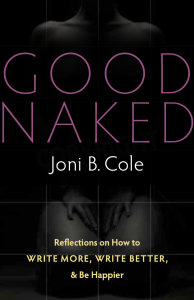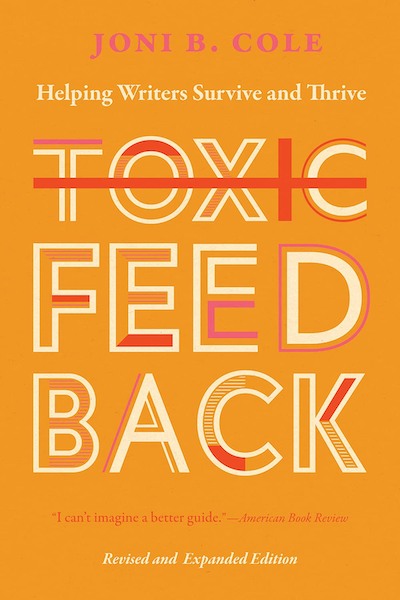
Today’s post is excerpted from the new revised edition of Toxic Feedback: Helping Writers Survive and Thrive by Joni B. Cole (@JoniBCole)
This story starts about eight years ago, with the arrival of a much anticipated email from the publishing house where the first edition of my book, Good Naked: How to Write More, Write Better, and Be Happier, was in production. Wrote the marketing coordinator:
Dear Joni,
Attached is the final version of the cover design for Good Naked, which the designer has asked me to pass along to you. Please note that the white gridlines are watermarks that won’t be present in the finished product…

Even now, years later, I get aftershocks thinking about the first time I opened the attachment and saw that cover design. There, filling my screen, was the image of a naked woman’s body, full-frontal, lingering in the shadows against a smoky backdrop. She was cut off from the neck up and knees down. Against the dark backdrop, two pink circles (representing the Os in the book’s title) drew the eye to the woman’s breasts. Her slender fingers formed a V, framing her pubis. And just below her private parts, spread across her silken thighs, was my book’s subtitle—How to Write More, Write Better, and Be Happier.
In summary, the proposed cover for my book—a cheerful and practical writing guide based on my decades of experience as an author and teacher—depicted a nude, headless woman, beckoning book browsers from the shadows like a back-alley sex worker.
Here, I feel compelled to state that I have nothing against back-alley sex workers. I also will concede that, yes, my writing guide has the word “naked” in its title, but so do a lot of other books, like Naked Statistics, which has a pie chart on its cover. So, when the designer saw the title of my manuscript, what made him think of soft porn? Why did he design a cover better suited to an entirely different type of book, say Fifty Shades of Writing?
I reread the email to make sure I had not misunderstood.
Final version of the cover…Please note that the white gridlines…
Could the marketing coordinator who had written this email to me be any more misguided? How could she think that a few barely perceptible gridlines on the enclosed image would be my primary concern, when there was my name—Joni B. Cole—attached to a work suggesting much more for sale than writing advice?
This story comes to mind as I think about feedback during the publishing process. In this situation, I, the author, was the one tasked with providing feedback, despite being told the cover design was “final” and despite my fear of consequences. I worried that my book was already on a tight production schedule. Could the designer refuse to make changes? If I refused his refusal, could the publisher delay my book’s release, or even pull it from their list? Would I end up blacklisted from the industry, a note on my file listing me as unpleasant, uncooperative, and unwilling to do nudity?
All sorts of worries, real and irrational, cluttered my thinking. But, given the situation, I felt like I had no choice but to reject this cover wholesale. I imagined my new release displayed in the creative-writing section of my daughter’s college bookstore. (And she thought I had embarrassed her in the past!) For moral support, I showed the cover to a few friends, seeking their reactions:
“Is this a joke?”
“Whoa! I thought maybe you’d been exaggerating.”
“Is it me, or is that woman about to get busy with herself?”
The only positive comment about the cover came from my friend Dan. “It’s not that bad,” he shrugged. “Maybe it will sell some books.”
Yeah, right, I thought, and maybe people will assume those are my silken thighs. But that doesn’t make it right.
My friend Dan did make a valid point. Helping a book sell is indeed one of the main considerations when designing its cover. Depending on your publishing contract, you may not have much, or any, say in the final design, and that isn’t completely unreasonable.
Few authors double as designers. Our forte is plot points, not graphic concepts. We may be too wedded to our own artistic sensibilities, right down to our favorite colors. (That dusty rose looked so nice on my bridesmaids’ dresses.) Meanwhile, we aren’t thinking about the big stuff that professional cover designers know to consider. Stuff like, What is in tune with your book’s tone and audience? What is most likely to draw a browser’s attention? What is on trend? Is the type readable from a distance? Is the cover going to work when it is in the form of a one-inch-high icon on Amazon?
In short, if you do have a say in the final design of your cover, just be sure to carefully weigh your tastes against the designer’s eye and marketing expertise. What looks good on your wall won’t necessarily look good on your cover. Also, be aware that you may not love your cover at first sight, but in the end you have to ask yourself whether you will be proud of putting it out there. Remember, people actually do judge a book by its cover, so you don’t want to get in the way of having your new release make a great first impression.
You also don’t want to be one of those authors. My friends who work in publishing have told me stories—oh, how they have told me stories. The following is just one of them. An author of a scholarly book received a cover whose image was one of her choosing, but she was so unhappy about the other elements (apparently the color of the subtitle made her “vomit”) she spammed the designer, the art production manager, the managing editor, the director of the press, and even the CFO. The one person she couldn’t immediately harass was her editor, who was away at a week-long conference. The press director called the editor and told her to “rein in her author,” which was no small task. In the end, almost everyone at the press stopped taking this author’s calls, and while the cover issue was eventually resolved, the author chose to communicate solely with the managing editor after that point.
While much of this chapter has dealt with feedback related to your book’s cover, typically this is the issue (as well as your book’s interior design) where you may have the least input, depending on your contract. Almost every other step of the publishing process, however, invites two-way feedback as you work with your developmental editor, your copy editor, and the marketing team.
As noted in another chapter in this book, it is important to speak up if you truly disagree with, say, your developmental editor’s suggestion to drop the first three chapters. But before you react or overreact, just keep this in mind: My gawd, you are working with a real, live professional editor! (And, trust me, if your real, live professional editor is bored by your opening, your readers are likely to feel the same.) Also, I would not recommend crossing your copy editor, not unless you are the kind of person who knows the past tense of the verb forsake, all 430 uses of the word set, and whether this is the correct spelling of Kyrgyzstan.
All this to say, don’t fail to put your foot down when necessary, but also listen, really listen to the professionals. Be open to their advice, and carry that open-mindedness through every step of the publishing process, from the finalization of the manuscript, through the production of the actual book, through sales and promotion. There is feedback … and then there is feedback from people who make their living publishing dozens and dozens of books a year.
“Trust the process,” as one of my editors once said to me. “The author-publisher relationship is not a competition. It’s a partnership, a dynamic. The publisher is invested financially,” she reminded me, “so they want your book to succeed in every way possible.”
And here I had assumed she’d been working so hard on my manuscript simply because she was my friend.
Epilogue
In case you are curious about what happened to that naked woman on the “final” cover of my writing guide, here is the rest of the story. As soon as I saw that image, I called my editor in a state of high dudgeon. As it turns out, he shared my low opinion of the cover choice, but the designer had voted him down. “Don’t sweat it for now,” my editor told me. “Marketing is on your side as well.” This begged the question: Who was this designer with such sway he could override both my editor and the folks in marketing?
Weeks passed. My print date drew near. Each time I checked in on my sex worker, I was told that the designer remained reluctant to remove her from my cover. As a seasoned author, I am not afraid to speak my mind, but I am also not big on ultimatums. “Replace that cover—or me and my book are walking!” For me, it still feels like a miracle when a publisher accepts my work. It was unfathomable to think I would do anything to jeopardize my “forthcoming release,” two words I love dropping into every conversation. But I just couldn’t accept that cover. This felt bigger than a battle over design. This had the stink of misogyny.
Finally, I got word. Fifty Shades of Writing was no more—I would see a new cover option for Good Naked by the end of the day. This news came in the form of an email from the same marketing coordinator who, weeks earlier, had sent along the original design. In this message she wrote:
Dear Joni,
I’m sorry for your sleepless nights…I don’t know whether I should be putting this in writing, but in all my time here, I don’t think I’ve ever been this opposed to a cover design. I’m rather ashamed that I knuckled under and sent it to you anyway, and I can only imagine how you must have felt.
Later that afternoon the designer put together an alternative with the image of a fountain pen beside a notepad, similar to the clip art used in dozens of writing-related blogs and a far cry from capturing the energy and tone of my book. In forwarding this iteration, the marketing coordinator had failed to delete the designer’s email to her, which I am sure was not intended for my eyes—“See if she’ll like this one,” he had written, as if I were some diva with an endless list of ludicrous demands—No, I said blue M&Ms! Not green! Not red! Blue!
Given I felt my cover deserved more than clip art, I hired an outside graphic designer to submit a different concept. The publisher ultimately chose this cover option for my book, though I heard through the grapevine that the Fifty Shades of Writing designer didn’t like it. (Perhaps he was distracted by the white gridlines?) So, all’s well that ends well, though this story has one more chapter.
About a year after the release of Good Naked, the publishing house went under, which was a real blow not just because it orphaned my book, but because of all the talented and lovely people who worked at the press, and all the meaningful titles it had released to the world for almost fifty years. I was lucky to find my own happy ending, however, as Good Naked was picked up by a different publisher that invited me to create a second edition. Oh, and it was love at first sight when they showed me their revised version of the cover!
Now, in my better moments, when I think about that designer with whom I so fervently disagreed, I try to let bygones be bygones. I hope that he found employment at some other publishing house, assuming he is no longer living out his male fantasies on the covers of other authors’ new releases. But if the challenge of my own cover struggle has taught me anything, it is this: There is good naked, and there is bad naked, but only one of those can help you write more, write better, and be happier, and it is not the one that has anything to do with soft porn.
Joni B. Cole is the author of seven books, including the new release Party Like It’s 2044: Finding the Funny in Life and Death; Good Naked: How to Write More, Write Better, and Be Happier; and Toxic Feedback: Helping Writers Survive and Thrive. For twenty-five years, she has taught creative writing to adults through her own Writer’s Center, as well as at academic programs and conferences around the country. She also runs the Good Naked Weekend Write-Away in White River Junction, Vermont. Find her at: www.jonibcole.com or www.thewriterscenterwrj.com


As usual, smart writing advice from Joni Cole that makes me laugh out loud.
Awesome piece. Almost unbelievable about the first (final) cover!
I still can’t believe it!
Joni Cole’s wit, authenticity, and sharp insight make this insider account of book cover design an essential read.
That’s the Joni we have come to love, using her light and lively voice to encourage us to use ours.
As a fan of Joni’s workshops and books, I love hearing the backstory of Good Naked’s original cover: https://www.amazon.com/Good-Naked-Reflections-Better-Happier-ebook/dp/B07NNTHH1Y/
I do prefer the revised expanded edition cover from her new publisher: https://www.amazon.com/Good-Naked-Happier-Revised-Expanded-ebook/dp/B0B8L57HT8/
Jane, perhaps you should add these images to this blog post?
Thanks, Stacy. I’ve now added links in the article if people would like to check out the covers.
OH, DEAR GOD. You handled this with more grace and patience than I might have been able to muster. Great story–happy ending (the right kind)–and I love the message of authors not being afraid to advocate for themselves and their careers…while still being professional.
So funny…I laughed out loud. What a great story.
Thx for the comment, Amanda. The experience was a good lesson for me… at some point even the worst publishing stories can be funny. (Eventually!) I appreciate your kind words about the essay.
Good Naked and Toxic Feedback are permanent fixtures on my writing table, and I refer to these wise and hilarious books regularly. Joni Cole’s knowledge of the craft and sense of humor are great company.
What sage advice and thank you for sharing your torment and struggle through the process of finding the right cover.
I’m a first-time author dealing with this exact topic right now! Thanks for publishing such a helpful (and funny) piece.
Glad it helped, Betsy. And best of luck with your own cover story!